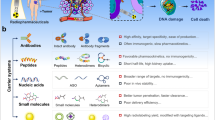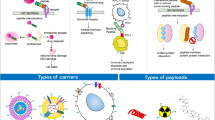Abstract
One main issue with peptide-based molecular imaging probes is their relatively low tumor affinity and short retention time. To improve peptide binding affinity, multivalency approach has been introduced. Traditionally, this approach involves the use of peptide homodimers or homomultimers in which peptide ligands of the same type are constructed with suitable linkers. Recently, a new approach using peptide heterodimers has emerged as a promising method for targeting multi-receptor over-expressed tumor cells. Significant affinity enhancements have been observed with peptide heterodimers compared with their parent peptide monomers. In a peptide heterodimer, two different peptide ligands capable of targeting two different receptors are covalently linked. The binding modes of peptide heterodimers can be monovalent or bivalent depending on whether simultaneous binding of two ligands can be achieved. Increased local ligand concentration and improved binding kinetics contribute to enhanced binding in both monovalent- and bivalent binding modes, while multivalency effect also plays an important role in bivalent binding mode. As many tumors overexpress multiple receptors, more peptide heterodimer-based molecular imaging probes are expected to be developed in future. This review article will discuss the peptide homodimers and heterodimers for molecular imaging with special emphasis on peptide heterodimers.














Similar content being viewed by others
References
Aloj L, Morelli G (2004) Design, synthesis and preclinical evaluation of radiolabeled peptides for diagnosis and therapy. Curr Pharm Des 10:3009–3031
Benedetti E, Morelli G, Accardo A, Mansi R, Tesauro D, Aloj L (2004) Criteria for the design and biological characterization of radiolabeled peptide-based pharmaceuticals. BioDrugs 18:279–295
Handl HL, Vagner J, Han H, Mash E, Hruby VJ, Gillies RJ (2004) Hitting multiple targets with multimeric ligands. Expert Opin Ther Targets 8:565–586
Josan JS, Vagner J, Handl HL, Sankaranarayanan R, Gillies RJ, Hruby VJ (2008) Solid-phase synthesis of heterobivalent ligands targeted to melanocortin and cholecystokinin receptors. Int J Pept Res Ther 14:293–300
Kwekkeboom D, Krenning EP, de Jong M (2000) Peptide receptor imaging and therapy. J Nucl Med 41:1704–1713
Li ZB, Cai W, Cao Q et al (2007) (64)Cu-labeled tetrameric and octameric RGD peptides for small-animal PET of tumor alpha(v)beta(3) integrin expression. J Nucl Med 48:1162–1171
Li ZB, Chen K, Chen X (2008a) (68)Ga-labeled multimeric RGD peptides for microPET imaging of integrin alpha(v)beta (3) expression. Eur J Nucl Med Mol Imaging 35:1100–1108
Li ZB, Wu Z, Chen K, Ryu EK, Chen X (2008b) 18F-labeled BBN-RGD heterodimer for prostate cancer imaging. J Nucl Med 49:453–461
Liu S (2006) Radiolabeled multimeric cyclic RGD peptides as integrin alphavbeta3 targeted radiotracers for tumor imaging. Mol Pharm 3:472–487
Liu S, Edwards DS, Ziegler MC, Harris AR, Hemingway SJ, Barrett JA (2001) 99mTc-labeling of a hydrazinonicotinamide-conjugated vitronectin receptor antagonist useful for imaging tumors. Bioconjug Chem 12:624–629
Liu Z, Liu S, Wang F, Chen X (2009a) Noninvasive imaging of tumor integrin expression using (18)F-labeled RGD dimer peptide with PEG (4) linkers. Eur J Nucl Med Mol Imaging 36:1296–1307
Liu Z, Niu G, Shi J, Liu S, Wang F, Chen X (2009b) (68)Ga-labeled cyclic RGD dimers with Gly3 and PEG4 linkers: promising agents for tumor integrin alphavbeta3 PET imaging. Eur J Nucl Med Mol Imaging 36:947–957
Liu Z, Yan Y, Chin FT, Wang F, Chen X (2009c) Dual integrin and gastrin-releasing peptide receptor targeted tumor imaging using 18F-labeled PEGylated RGD-bombesin heterodimer 18F-FB-PEG3-Glu-RGD-BBN. J Med Chem 52:425–432
Liu Z, Li ZB, Cao Q, Liu S, Wang F, Chen X (2009d) Small-animal PET of tumors with (64)Cu-labeled RGD-bombesin heterodimer. J Nucl Med 50:1168–1177
Liu Z, Niu G, Wang F, Chen X (2009e) (68)Ga-labeled NOTA-RGD-BBN peptide for dual integrin and GRPR-targeted tumor imaging. Eur J Nucl Med Mol Imaging 36:1483–1494
Liu Z, Yan Y, Liu S, Wang F, Chen X (2009f) 18F, 64Cu, and 68 Ga labeled RGD-bombesin heterodimeric peptides for PET imaging of breast cancer. Bioconjug Chem 20:1016–1025
Mammen M, Choi S-K, Whitesides G (1998) Polyvalent interactions in biological systems: implications for design and use of multivalent ligands and inhibitors. Angew Chem 37:2755–2794
Pillai R, Marinelli ER, Swenson RE (2006) A flexible method for preparation of peptide homo- and heterodimers functionalized with affinity probes, chelating ligands, and latent conjugating groups. Biopolymers 84:576–585
Reubi JC, Waser B (2003) Concomitant expression of several peptide receptors in neuroendocrine tumours: molecular basis for in vivo multireceptor tumour targeting. Eur J Nucl Med Mol Imaging 30:781–793
Sharma SD, Jiang J, Hadley ME, Bentley DL, Hruby VJ (1996) Melanotropic peptide-conjugated beads for microscopic visualization and characterization of melanoma melanotropin receptors. Proc Natl Acad Sci USA 93:13715–13720
Shrivastava A, von Wronski MA, Sato AK et al (2005) A distinct strategy to generate high-affinity peptide binders to receptor tyrosine kinases. Protein Eng Des Sel 18:417–424
Shrivastava A, Nunn AD, Tweedle MF (2009) Designer peptides: learning from nature. Curr Pharm Des 15:675–681
Tweedle MF (2006) Adventures in multivalency, the Harry S. Fischer memorial lecture CMR 2005; Evian, France. Contrast Media Mol Imaging 1:2–9
Tweedle MF (2009) Peptide-targeted diagnostics and radiotherapeutics. Acc Chem Res 42:958–968
Vadas O, Rose K (2007) Multivalency—a way to enhance binding avidities and bioactivity—preliminary applications to EPO. J Pept Sci 13:581–587
Vagner J, Xu L, Handl HL et al (2008) Heterobivalent ligands crosslink multiple cell-surface receptors: the human melanocortin-4 and delta-opioid receptors. Angew Chem Int Ed Engl 47:1685–1688
Wu Y, Zhang X, Xiong Z et al (2005) microPET imaging of glioma integrin {alpha}v{beta}3 expression using (64)Cu-labeled tetrameric RGD peptide. J Nucl Med 46:1707–1718
Wu Z, Li ZB, Chen K et al (2007) microPET of tumor integrin alphavbeta3 expression using 18F-labeled PEGylated tetrameric RGD peptide (18F-FPRGD4). J Nucl Med 48:1536–1544
Xu L, Vagner J, Josan J et al (2009) Enhanced targeting with heterobivalent ligands. Mol Cancer Ther 8:2356–2365
Ye Y, Bloch S, Xu B, Achilefu S (2006) Design, synthesis, and evaluation of near infrared fluorescent multimeric RGD peptides for targeting tumors. J Med Chem 49:2268–2275
Zaccaro L, Del Gatto A, Pedone C, Saviano M (2009) Peptides for tumour therapy and diagnosis: current status and future directions. Curr Med Chem 16:780–795
Zhang X, Xiong Z, Wu Y et al (2006) Quantitative PET imaging of tumor integrin alphavbeta3 expression with 18F-FRGD2. J Nucl Med 47:113–121
Author information
Authors and Affiliations
Corresponding author
Rights and permissions
About this article
Cite this article
Yan, Y., Chen, X. Peptide heterodimers for molecular imaging. Amino Acids 41, 1081–1092 (2011). https://doi.org/10.1007/s00726-010-0546-y
Received:
Accepted:
Published:
Issue Date:
DOI: https://doi.org/10.1007/s00726-010-0546-y




